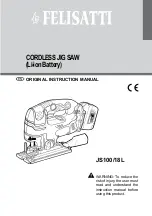
E N G L I S H
33
b)
Adjust the riving knife as described in
this instruction manual.
Incorrect spacing,
positioning and alignment can make the riving
knife ineffective in preventing kickback.
c)
For the riving knife to work, it must be
engaged in the workpiece.
The riving knife is
ineffective in preventing kickback during short
cuts.
d)
Do not operate the saw if riving knife is bent.
Even a light interference can slow the closing
rate of a guard.
Additional safety instructions for
plunge-type saws
•
Wear ear protectors.
Exposure to noise can
cause hearing loss.
• Wear a dust mask.
Exposure to dust particles
can cause breathing difficulty and possible
injury.
• Do not use blades of larger or smaller
diameter than recommended.
For the proper
blade rating refer to the technical data. Use only
the blades specified in this manual, complying
with EN 847-1.
• Never use abrasive cut-off wheels
.
Residual risks
• In spite of the application of the relevant
safety regulations and the implementation of
safety devices, certain residual risks cannot be
avoided.
These are:
– Impairment of hearing.
– Risk of accidents caused by the uncovered
parts of the rotating cutting disc.
– Risk of injury when changing the disc.
– Risk of dust inhalation from materials that
when cut, can be harmful.
Labels on tool
The following pictogram is shown on the tool:
Blade
diameter
Additional safety instructions for
battery packs and chargers
• Make sure that the battery pack is dry and
clean before inserting it into the charger.
• Use only chargers labelled with “Li-Ion” to
charge D
E
WALT Lithium Ion battery packs.
• Never carry the charger by its cord. Never pull
the cord to disconnect from the socket. Keep
the cord away from heat, oil and sharp edges.
• Have any damaged or defective cords replaced
by an authorised D
E
WALT repair agent. Never
attempt any repairs yourself.
• Do not expose the charger to damp or wet
conditions.
• Do not attempt to charge wet battery packs.
• Never attempt to open a battery pack for any
reason.
• Charge only battery packs with the ratings as
specified in this manual. Do not attempt to
charge non-rechargeable batteries.
• Always follow the instructions in the back of this
manual for battery pack disposal.
• When not in use, chargers and battery packs
must be stored in a dry place and locked up
securely, out of reach of children.
STORAGE RECOMMENDATIONS
1. The best storage place is one that is cool and
dry away from direct sunlight and excess heat
or cold.
2. Long storage will not harm the battery pack or
charger. Under proper conditions, they can be
stored for 5 years or more.
Labels on charger and battery pack
In addition to the pictographs used in this manual,
the labels on the charger and the battery pack show
the following pictographs:
Read instruction manual
before use.
Do not expose to water.
Do not probe with conductive objects.
Do not charge damaged battery packs
Do not use damaged chargers
Charge only between 4 °C and 40 °C.
Have defective cords replaced
immediately.
Charger problem
Содержание DC351
Страница 1: ...DC351 www eu ...
Страница 3: ...1 n p Figure 1 c b a h d f g e j j k l m n o Figure 2 q n ...
Страница 4: ...2 Figure 3 Figure 4 r s k u t v 2 3 mm 2 3 mm l m ...
Страница 5: ...3 Figure 5 f Figure 6 d h c ...
Страница 6: ...4 Figure 7 Figure 8 w aa w bb y z ...
Страница 168: ......
Страница 169: ......
















































